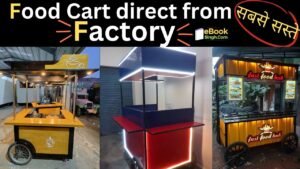Food Cart Business in India: A Step-by-Step Guide
1. Understanding the Food Cart Business
1.1 Overview of the Food Service Industry in India
The food service industry in India is a vibrant and ever-evolving sector that encompasses various dining formats, from fine dining to street food. In recent years, food carts have gained significant popularity due to urbanization and the rise of quick-service dining options.
you can Buy food cart – whatsapp-9350493713
more details you can watch this video click here…
- Trends and growth opportunities: The fast-paced lifestyle of urban dwellers creates a demand for quick, affordable food options. This trend offers ample opportunities for food cart entrepreneurs to cater to busy professionals, students, and families.
- Popular food categories for cart businesses: Some of the most popular food items sold from carts include famous street foods like pav bhaji, chaat, vada pav, and even international flavors like burgers and pizza.
- Impact of urbanization and lifestyle changes: With increasing urbanization, more people are seeking convenience and variety in their meals. This shift lays the groundwork for food carts to thrive in cities and towns alike.
1.2 Benefits of Starting a Food Cart Business
Starting a food cart can be a fantastic option for aspiring entrepreneurs due to various benefits.
- Low initial investment compared to restaurants: Setting up a food cart generally requires significantly less capital than opening a restaurant, making it a more accessible option for many.
- Flexibility in location and menu offerings: Food cart owners can easily move their carts to different locations based on foot traffic, events, or festivals. Plus, they have the freedom to change their menu based on what resonates with their customers.
- Ability to test markets with varying cuisines: Operating a food cart allows entrepreneurs to experiment with different cuisines. If one idea doesn’t work, it’s simple to pivot without the risks associated with a full restaurant.
1.3 Challenges Faced by Food Cart Entrepreneurs
Despite the advantages, starting a food cart business isn’t without challenges.
- Regulatory hurdles and licenses needed: Navigating the various permits and licenses can be daunting. Ensuring compliance with local regulations is crucial.
- Competition from established food vendors: The food cart space can be crowded, and standing out among other vendors requires creativity and a solid marketing strategy.
- Seasonal variations affecting sales: Sales can fluctuate based on the season or weather conditions. Being prepared for these changes can help maintain a steady income.
2. Planning Your Food Cart Business
2.1 Defining Your Concept and Target Audience
Before moving forward, it’s essential to outline your vision and understand your audience.
- Choosing a cuisine that resonates with your audience: Research popular food trends and consider what’s missing in your area. Find a niche that excites you and attracts customers.
- Identifying your unique selling proposition (USP): Determine what makes your food cart different. Whether it’s unique recipes or a distinctive twist on a classic dish, your USP will help set you apart.
- Understanding customer preferences and trends: Stay updated with food trends, and engage with customers to understand their likes and dislikes.

2.2 Creating a Business Plan
A well-thought-out business plan is your roadmap for success.
- Elements of a solid business plan for a food cart: Include your concept, menu, target market, and competitive analysis. Set realistic goals and strategies to achieve them.
- Financial projections and budgeting: Plan your finances carefully. Consider all expenses such as equipment, ingredients, licenses, and marketing. It’s wise to have a buffer for unexpected costs, too.
- Marketing strategy to attract customers: Outline how you will promote your food cart—be it through social media, local events, or traditional methods like flyers.
2.3 Selecting the Right Location
Finding the perfect spot can significantly impact your success.
- Importance of foot traffic and visibility: High foot traffic locations near offices, schools, or parks are ideal. A visible cart is more likely to attract customers.
- Evaluating potential sites (markets, events, etc.): Scout different neighborhoods and local events. Research where potential customers gather and see where your food cart fits.
- Understanding local demographics and their needs: Study the demographics of your chosen location. Tailor your menu to cater to the preferences of that audience.
3. Legal Requirements and Licensing
3.1 Understanding Food Safety Regulations
Maintaining food safety is paramount in the food business.
- Essential food safety certifications: Depending on the region, you may need certifications to ensure safe food handling.
- Hygiene and sanitation practices to follow: Establish strict hygiene protocols to avoid foodborne illnesses.
- Importance of maintaining quality standards: Consistency is key. Ensure the quality of your food remains high to build a loyal customer base.

3.2 Obtaining Permits and Licenses
Navigating the paperwork can be time-consuming but is essential.
- List of required permits for operating a food cart: This may include local health permits, food vendor licenses, and even trade licenses.
- Process for applying for these permits: Contact local government offices or health departments to get guidance on obtaining necessary permits.
- Common challenges in obtaining licenses: Be prepared for potential delays or bureaucratic hurdles. Patience and persistence will be necessary.
You can also read eBooks for food Business–

3.3 Complying with Local Laws and Regulations
Stay informed about local regulations.
- Navigating local government guidelines: Familiarize yourself with the specific rules governing food carts in your area.
- Understanding zoning laws for food carts: Ensure you operate in areas where food carts are permitted. Some places may have restrictions on where you can park.
- Importance of staying updated on legal changes: Regulations can change, so keep abreast of any modifications that may affect your business.
4. Setting Up Your Food Cart
4.1 Designing Your Food Cart
Your food cart’s design will play a crucial role in attracting customers.
- Key elements to consider in cart design: Consider functionality, aesthetics, and space availability. A colorful and inviting cart can draw in passersby.
- Importance of branding and signage: Create clear signage that communicates what you offer. Strong branding helps to build recognition.
- Effective use of space and equipment setup: Optimize your cart’s layout for efficiency, ensuring you have room for cooking, serving, and customer interaction.
4.2 Sourcing Ingredients and Supplies
Quality ingredients can distinguish your food cart from the competition.
- Finding reliable suppliers for fresh ingredients: Build relationships with local farmers and suppliers to ensure you have access to fresh produce and ingredients.
- Budgeting for inventory and supplies: Keep track of your inventory and expenses. Finding the right balance between quality and cost is key.
- Tips for maintaining quality and consistency: Develop a system for receiving, storing, and using ingredients to uphold standards.
watch video for more detail–
4.3 Equipment and Tools Needed
Having the right tools can make your operations smoother.
- Essential equipment for a food cart: Items like cooking appliances, utensils, storage containers, and a cash register are foundational.
- Affordable options for starting out: Research second-hand equipment or rental options to save on initial costs.
- Maintenance and care for your equipment: Regularly clean and maintain your tools to ensure efficiency and safety.
5. Marketing Strategies for Your Food Cart
5.1 Building an Online Presence
In today’s digital age, online visibility is vital.
- Importance of social media for food businesses: Platforms like Instagram and Facebook can help you showcase your offerings and connect with customers.
- Creating a website or food blog: Consider creating a simple website to share your menu, location, and any events where you’ll be present.
- Engaging with customers through online platforms: Respond to comments, encourage reviews, and share updates to stay connected with your audience.

5.2 Promotional Activities and Partnerships
Collaborations can boost your visibility.
- Collaborating with local events and festivals: Participating in events can introduce your food to new customers and create buzz.
- Running promotions and loyalty programs: Offering discounts or rewards can encourage repeat business.
- Networking with other food businesses: Build relationships with fellow vendors to share insights and explore collaboration opportunities.
5.3 Gathering Customer Feedback and Adapting
Customer input is invaluable for growth.
- Methods for collecting customer feedback: Create opportunities for customers to share their thoughts through surveys, social media, or in-person chats.
- Analyzing feedback for menu improvements: Use feedback to evolve your menu and services based on customer preferences.
- Importance of flexibility in menu offerings: Adapt to changing tastes and seasonal ingredients to keep your offerings fresh and appealing.

Conclusion
Starting a food cart business in India is an exciting venture filled with opportunity. By understanding the landscape, planning carefully, navigating legal requirements, setting up effectively, and employing strong marketing strategies, you can set yourself up for success. Take that first step, and with dedication and planning, your food cart can become a beloved staple in your community.
FAQs
What is the initial investment required for a food cart business in India?The initial investment can vary widely but generally ranges from ₹50,000 to ₹2,00,000, depending on the cart’s make, equipment, and startup costs.
How do I ensure compliance with food safety standards?Obtain necessary food safety certifications and adhere to hygiene practices. Regularly review local food safety guidelines to remain compliant.
Can I operate a food cart part-time?Yes, many entrepreneurs operate food carts part-time. This flexibility allows you to test the market while balancing other commitments.
What are some popular food items to sell from a food cart in India?Popular items include various street foods like dosas, idlis, and chaat, as well as burgers and sandwiches for a contemporary twist.
How do I attract customers to my food cart?Implement eye-catching signage, engage on social media, offer promotions, and participate in local events to create awareness and draw in customers.











